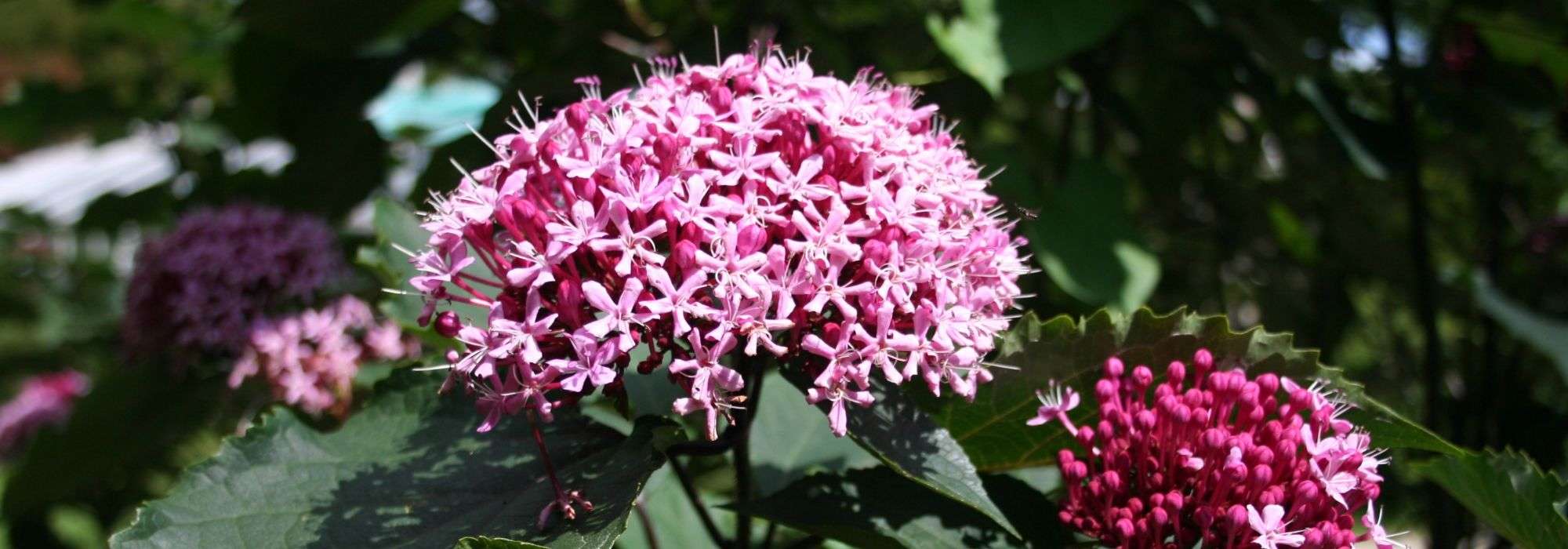
Clerodendron, glorybower: planting, pruning and care
Contents
Clérodendron, in a nutshell
- Clerodendrons are bushes 1 to 6 m tall or small trees with an exotic character.
- They display very distinctive, true-pink or white, highly fragrant flowering that attracts butterflies and other pollinating insects.
- These deciduous bushes are easily recognised by the strong scent of the leaves when crushed, and some varieties have variegated white foliage that helps brighten shaded areas in the afternoon.
- The very fragrant flowering that occurs in late summer to autumn is followed by attractive fruiting with china-blue berries, ringed by a red collar.
- Clerodendrons prefer deep, fertile soil rich in humus, not too heavy, well-drained yet moist, and a sunny to semi-shaded position sheltered from strong winds.
A word from our expert
The genus Clerodendrum includes plants, trees, bushes, herbaceous and climbing species that are found more often in tropical regions than here. Most of these exotically accented plants live in warm climate, in tropical Africa and South Asia. However, there are two temperate-climate species native to China or Japan: Clerodendrum bungei and trichotomum. The latter is even nicknamed the Lucky Tree or Clergyman’s Tree!
These bushes, very easy to grow throughout France, produce a delicate, exceptionally beautiful and fragrant flowering, which renews the sequence of flowerings begun in spring and brings the season to a superb close. These deciduous, erect bushes fit well, even in a very small space, within an informal hedge and can accommodate a perennial bed at their base, such as Japanese anemones.
Clerodendrum trichotomum forms a large bush 3 m tall by 2 m wide, with large heart-shaped leaves whose crushing releases an unpleasant odour. This Clerodendrum can also be trained into an elegant small tree, 5 to 6 m tall, if you take care to clear the base of the trunk. Its dense branches bear large panicles of star-shaped white flowers, tinged pale mauve with age, delightfully scented, in late summer. Interest continues with fruiting made up of berries of an exceptional metallic blue colour, highlighted by the calyx which turns bright red. Clerodendrum bungei, which forms a bush less than 2 m high, is a little more tender to cold (-10°C) but can regrow from the stump. It tolerates heat better than the previous species. It also tends to send out suckers but displays very beautiful true-pink scented inflorescences followed by turquoise berries.
Clerodendrums in our gardens appreciate fertile, deep, not-too-heavy soil and a sunny spot sheltered from strong winds. However, they tolerate partial shade better in the South. Their hardiness ranges from -10 to -17°C. They require very little maintenance: the only pruning needed is to open out the centre of the clump to let light in or to cut back wood damaged by frost.
Description and botany
Botanical data
- Latin name Clerodendrum
- Family Lamiaceae
- Common name Clerodendron, glorybower, chance tree, Clergyman's tree, Turquoise tree
- Flowering from August to October
- Height between 1 and 6 m
- Sun exposure sun or partial shade
- Soil type any loose, deep and well-drained soil
- Hardiness tender to good (0 to -17 °C)
Vast genus Clerodendrum comprises more than four hundred species of trees, bush, climbing plants and even herbaceous forms, with deciduous or evergreen foliage. Some species produce spectacular flowering, such as Clerodendrum thomsoniae, a climbing clerodendron sold as a compact flowering plant with clusters of white and red flowers, Clerodendrum paniculatum with huge salmon panicules, or Clerodendrum myricoides ‘Ugandense’ (syn C. ugandense) whose two-toned blue flowers evoke butterflies. Majority of clerodendrons come from tropical regions of Africa or South Asia, except two species adapted to temperate climates that have become very popular in gardens for their rapid growth and decorative interest: Clerodendrum bungei native to China, Taiwan, Vietnam and the Himalayas and Clerodendrum trichotomum, from China and Japan.
Clerodendrons formerly placed in family Verbenaceae now belong to family Lamiaceae according to phylogenetic classification, even if resemblance to sage is less obvious! Name derives from Greek kléros, luck, and dendron, tree, hence translation “Tree of luck”. This name refers to plant’s properties, which can be medicinal or toxic!
Foliage, deciduous in our two main garden species, is simple, opposite, borne on long petioles up to 10 cm long and strongly veined. Leaf of fetid clerodendron (C. bungei), measuring 15–20 cm long by 10–20 cm wide, is grossly dentate and young shoots are often coloured purple. That of Clergyman’s tree (C. trichotomum) is ovate, sometimes trilobed, with smooth undulate margins, ending in a fine point and downy beneath, as are young shoots. Leaves, larger on young specimens, may measure 17–25 cm long by 5–15 cm wide. In C. bungei foliage is a darker, shinier green, but both species include variegated cultivars such as Clerodendrum trichotomum ‘Variegatum’ and Clerodendrum bungei ‘Pink Diamond’. Clerodendron is easy to identify by distinctive foliage which releases an unpleasant odour when crushed, reminiscent of burnt peanut or even burnt rubber, especially in Clerodendrum bungei, also called fetid clerodendron (Clerodendrum foetidum). The latter also shows a strong tendency to sucker, especially if clump is cut back by cold, but remains moderate in vigour, 1–1.8 m versus 3–6 m for trichotomum.

Clerodendrons most popular: inflorescence of C. bungei, inflorescence and fruiting of C. trichotomum
In Clerodendrum, flowers, with 5 fused petals, are tubular and end in an expanded or cup-shaped form. Four stamens and a style arise (successively) from corolla as in all members of family Lamiaceae. Calyx is quite striking, forming a swollen, elongated angular pale green structure turning yellow-purplish in autumn in trichotomum before opening into a dark red star. It encloses a berry (or drupe) turquoise or bluish-green. Tiny flowers are gathered in cymes, rounded and erect in bungei, arranged in loose, nodding panicles in trichotomum. They diffuse a very pronounced floral scent that attracts butterflies and other late-summer and autumn pollinators. Fruiting is more or less regular depending on year and climate, notably in Bunge’s clerodendron.
Main varieties of Clerodendrum
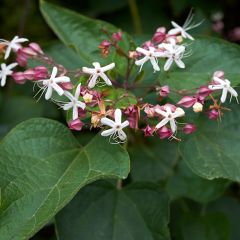
Clerodendrum trichotomum
- Flowering time September to November
- Height at maturity 3 m
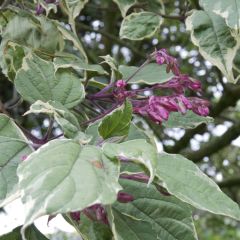
Clerodendrum trichotomum Variegatum
- Flowering time September, October
- Height at maturity 3 m
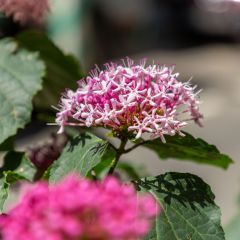
Clerodendrum bungei
- Flowering time September to November
- Height at maturity 1,80 m
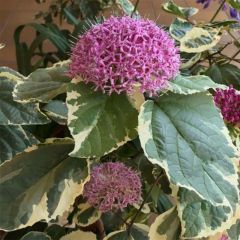
Clerodendrum bungei Pink Diamond
- Flowering time September to November
- Height at maturity 1,20 m
Discover other Clerodendrum
View all →Available in 2 sizes
Available in 1 sizes
Available in 2 sizes
Available in 1 sizes
Available in 2 sizes
Available in 2 sizes
Planting
Where to plant Clerodendrum?
Two species common in our regions: C. bungei and trichotomum tolerate approximately -10 to -17°C respectively, knowing that bungei regrows easily from stump after short frosts down to -15°C and then forms low, rounded bushes about 1 m high. Its aerial parts are destroyed by the first frosts. Heat-tolerant and indifferent to soil type provided it is deep, it adapts to many regions but dislikes climates that are too cold in winter. You can also to grow it in a large pot and bring it into an unheated greenhouse during winter.
Plant clerodendrums in fertile, humus-rich soil that is not too heavy. Bungei tolerates all soils, even dry and calcareous, provided they are deep and well worked at planting.
Prefer a sunny position sheltered from strong winds or east-facing if summers are hot, as this bush appreciates cool soil to flower well.
When to plant?
Prefer spring (March–April) to plant clerodendrums, or October–November in mild climates.
How to plant?
This plant is easy to grow whether in a border, as an individual specimen, in a hedge or in a container.
- Sink the pot into a bucket of water to thoroughly moisten it.
- Dig a wide hole at least three times the width of the rootball and 40 cm deep.
- Add leaf mould, sand enriched with an organic amendment (blood meal, crushed horn) if soil is poor.
- Place a 15 cm layer of gravel at bottom of hole if soil is heavy (sticky when wet).
- Place the plant in the planting hole.
- Replace soil and firm gently.
- Then spread a mulch at its base to help keep soil cool in summer.
- Water generously.
In a pot, ensure good drainage with clay balls placed at bottom of container and plant into a mix of potting compost and garden soil.
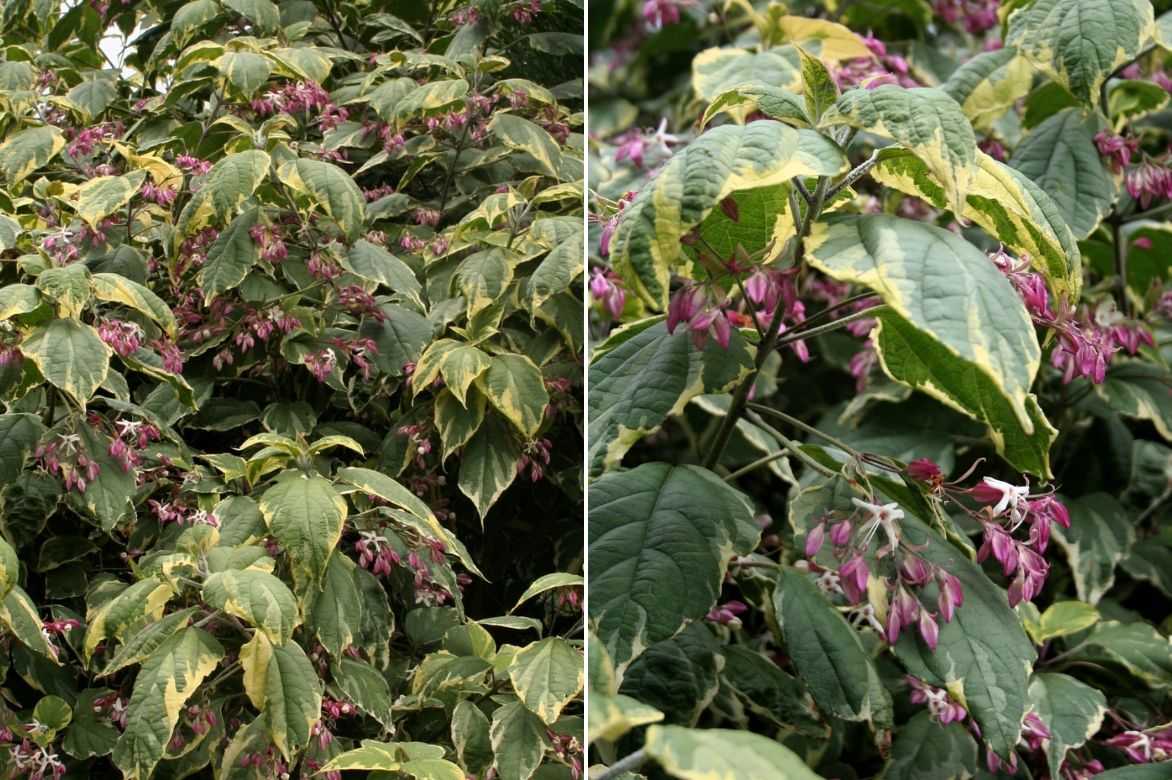
Superb variegated leaves of Clerodendrum bungei ‘Variegatum’
Care and pruning of Clerodendrum
- Ensure you keep soil moist for first two years after planting then water regularly during growing season.
- Remove unwanted shoots if necessary.
- In pots, apply a feed every 15 days during growing season or a single dose of slow-release fertiliser and water very regularly.
Pruning of clerodendrons
- Pruning of Clerodendrum bungei is carried out at end of winter, in March–April, to cut back branches to one quarter of their length. This pruning helps maintain a compact habit and encourage abundant flowering which occurs on current year’s shoots.
- Simply thin out branches of clerodendron trichotomum by removing thin twigs and, if desired, clear a trunk if you want to train it as a standard tree.
Clerodendrons are not particularly prone to disease but may suffer occasional attacks of scale insects, red spider mites or whiteflies, especially in conservatory.
Against mites, regularly mist your plants and spray rapeseed oil to smother scale insects. Whiteflies can be treated with black soap or pyrethrin.
Propagation
Simplest method of propagation is to separate suckers, as many species tend to send out suckers, but you can also take cuttings in March–April, particularly with greenhouse species.
Separation of suckers
After leaves have fallen, using a sharp spade, separate a sucker with rootlets by cutting the large horizontal root.
Replant it immediately, possibly shortening the stem to encourage establishment.
Propagation by cuttings
Particularly for species thomsoniae or speciosum grown indoors:
- Prepare a deep pot by filling it with potting compost mixed with sand.
- Take tips of young herbaceous shoots 10–15 cm long.
- Remove leaves situated near base of the cutting.
- Dip base in plant hormone powder.
- Insert them to two thirds of their length, avoiding contact between cuttings.
- Firm soil gently all around, water.
- Place the pot in a humid, enclosed environment at 20°C, covering with clear plastic or a plastic bottle.
- As soon as leaves appear, separate rooted cuttings and plant them in buckets to be grown in a greenhouse.
Uses and companion plants
When most plants in the garden are nearing the end of flowering, Clerodendrums unfurl their inflorescences — light, sparkling and highly fragrant — which pair delightfully with the flowering of Japanese anemones, asters, large sages (guaranatica, involucrata ‘Bethelii’…), the tawny colours of ornamental grasses or the old-rose of hydrangeas at the end of their flowering.
If the glory tree is already in itself a very handsome bush from mid-summer until leaf fall, variegated forms such as ‘Variegatum’ and ‘Pink Diamond’ bring a fresh light to borders or hedges from spring onwards. Plant perennials or bushes in white or tonal shades such as Deutzia, mock oranges, Spiraea to create a luminous white garden…
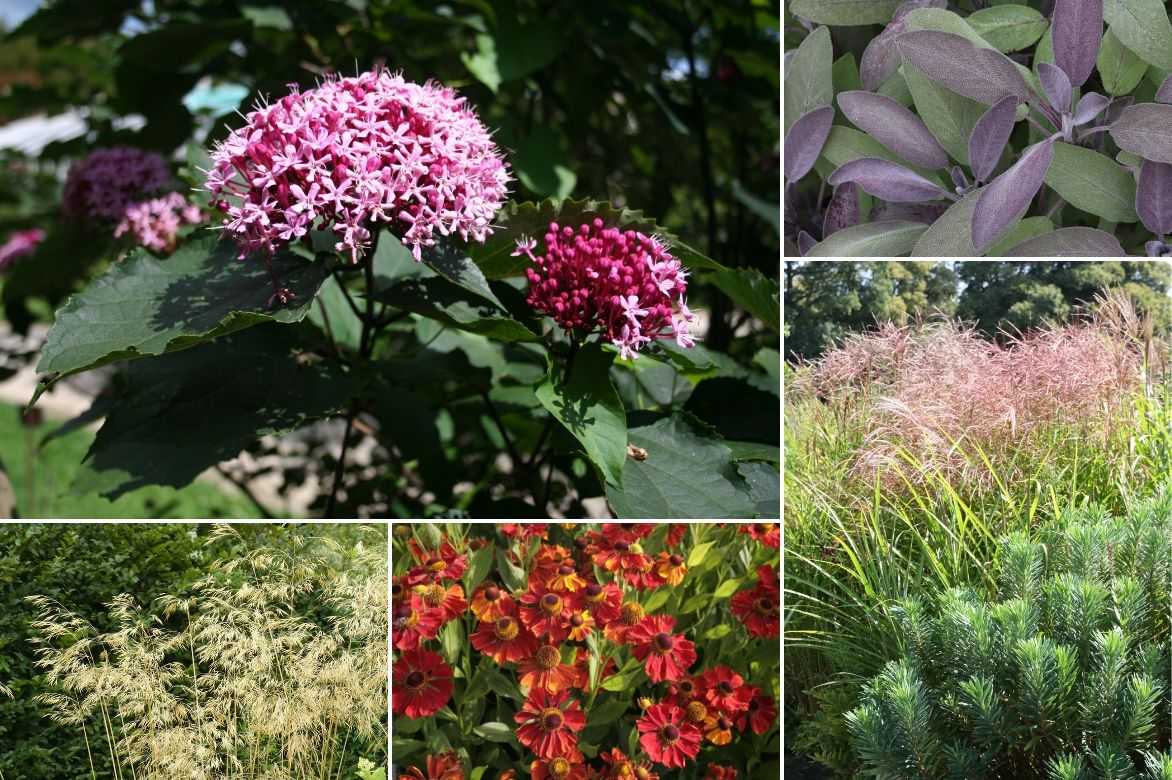
A lovely autumn planting combination: Clerodendron bungei, Salvia officinalis ‘Purpurascens’, Miscanthus (‘China’, ‘Dronning Ingrid’, ‘Malepartus’…), and Euphorbia characias, Helenium ‘Baudirektor Linne’ and Stipa gigantea
In a loose hedge or a shrub bed, consider adding autumn colours that will enhance the brilliance of their flowering, such as a deciduous Euonymus alatus, a Parrotia persica, a Japanese maple or a dyer’s vine (Vitis vignifera ‘Purpurea’). Modest-sized bushes can contribute to creating an ornamental, varied bed or hedge throughout the year such as Neilia affinis, spring Spiraea (arguta, Van Houttei, prunifolia) or summer Spiraea (S. japonica ‘Anthony Waterer’), viburnum opulus, mock oranges, buddleias and landscape roses paired with Clerodendron bungei.
Do not miss out on the fragrance of Clerodendrum trichotomum by placing it as a sentinel — trained on a stem or as a bush — near living areas or thoroughfares!
In a wild garden, the bee tree (Tetradium daniellii) and botanical roses complete the picture wonderfully with their small red autumn fruits that are a treat for birds.
- Subscribe!
- Contents
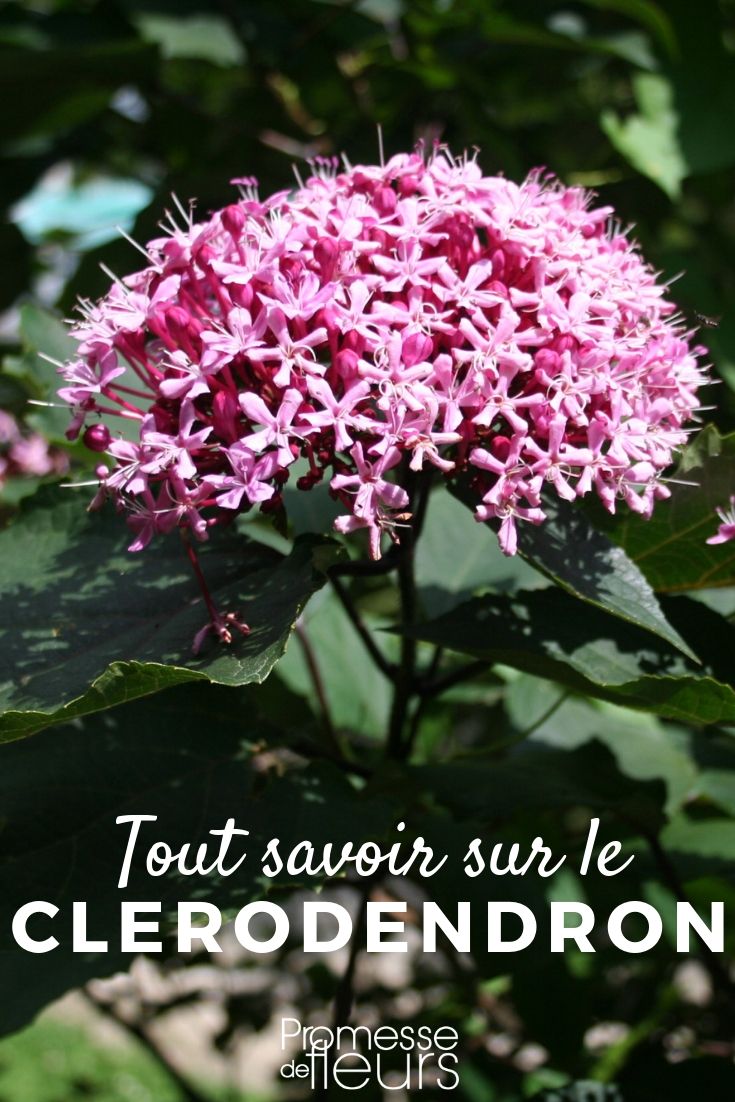































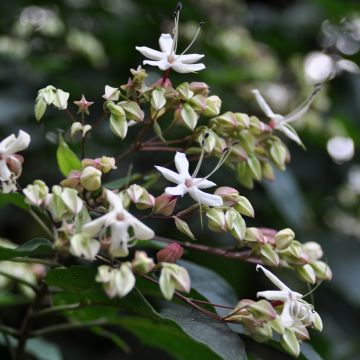


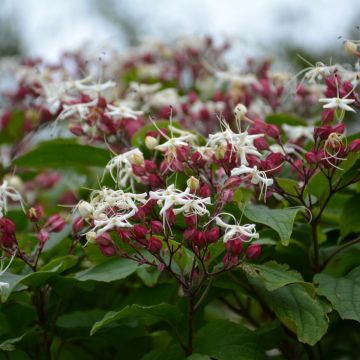


Comments